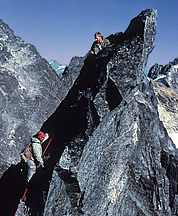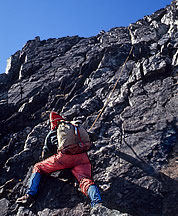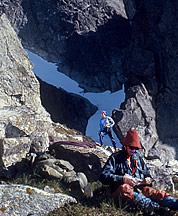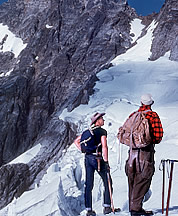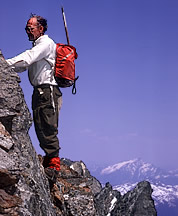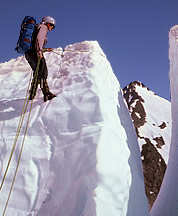|
|
|||||||||||||||
 |
||||||||||||||||
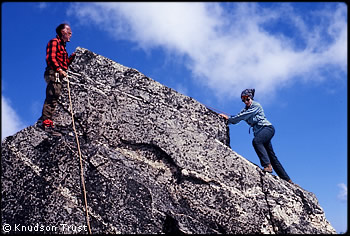 |
||||||||||||||||
|
||||||||||||||||
ountaineering is largely a sport for the young and unattached. College and the early years of a career, before family responsibilities grow, are the most active and adventurous times in a typical climber’s life. Marriage doesn’t change things much, but the arrival of children does. Many fathers (and a few mothers) are able to climb intensively with the support of a stay-at-home spouse. But married couples with young children rarely continue adventurous climbing together. To pursue exploratory mountaineering from youth through child-rearing until retirement—and to do it as a couple—is almost unheard of. In the North Cascades and British Columbia Coast Mountains, no one has managed this feat quite like Joe and Joan Firey. Early Years Born in October 1918, Joe Firey started life in Roundup, Montana. His father was a doctor and life in the small town revolved around coal mining and cattle ranching. When Joe was ten, the Milwaukee Railroad switched from coal to oil to run their trains. This nearly closed down the town and Joe’s father had to leave. The family spent a year in Arizona then moved to Seattle around the time of the stock market crash in 1929. Joe graduated from Roosevelt High School in 1936 and earned a mechanical engineering degree from the University of Washington in 1940. Joe was in the Boy Scouts for a short time where he met friends who were interested in hiking and climbing. They had no instruction. “We learned the hard way, or the blundering way,” recalled Joe, “how to do things and also how not to do things.” Money was tight. Joe made his own crampons by bending and heat-treating spring steel components and riveting them together. Joe recalled that the cheapest meat in those days was canned salmon, so they ate that frequently on climbing trips. Students didn’t have cars during the Great Depression so getting to the Cascades to climb was difficult. But by taking street cars and ferries, they could get from their homes in Seattle to the east side of the Olympic Mountains. The peaks of the upper Dosewallips River were Joe’s favorite summits during high school. In the summer of 1936, Joe and a younger friend hiked from the Brinnon ferry dock on Hood Canal to the summit of Mount Olympus and back. Traveling along the Dosewallips and Elwha Rivers and over three passes, they covered 120 miles on foot during their two-week journey.
In college, Joe’s friend Ray Longtin was able to borrow his father’s car, so they climbed in the Cascades more often, especially peaks around Snoqualmie Pass and as far east as the Teanaway River. They also climbed most of the Cascade volcanoes. In July 1939, Joe and two friends climbed Mount Rainier, the only time he ever climbed that peak. Joe met Joan Wilshire through the Sierra Club and they married in 1950. Born in August 1928, Joan was a physical therapist and budding artist. She thoroughly shared Joe’s enthusiasm for mountains and climbing. Joe and Joan eventually had three children: Carla, born in 1952; Nina, born in 1954; and Alan, born in 1956. In the latter part of 1954, the family moved to Seattle, where Joe took a job as a professor of mechanical engineering at the University of Washington. Joe worked at the U.W. for the rest of his career, retiring in 1981. Joe and Joan joined The Mountaineers after moving to Seattle and they immediately began doing weekend climbing trips in the Cascades. The Firey name made its debut in Cascade history in 1955, with a first ascent of Columbia Peak’s North Ridge. Joe recalled that the Monte Cristo area was more accessible in the 1950s than it is today, because you could still drive to the old mining town. In the early 1960s, the Fireys began their long association with the Picket Range, widely regarded as the most spectacular and rugged region in the Cascade Range. They visited the Northern Pickets in both 1960 and 1961, with parties that included Tony Hovey, Don Keller, Cal Magnusson, and Frank deSaussure. On the first trip they climbed Phantom, Crooked Thumb and a new route on Mount Challenger, the South Ridge. During the second trip, they added Luna and both summits of Mount Fury. The traverse between East and West Fury was a new route, previously attempted by members of the Ptarmigan Climbing Club in 1940. Joe recalled that the rock was crumbly and you had to really watch your step. “Everything was movable,” he said, “and yet it was up at a high angle.” The Fireys bivouacked on the traverse, something earlier parties had not been prepared to do. Their greater commitment was the key to their success.
In 1961 they made their first trip to the Southern Pickets, focusing on the seldom visited Crescent Creek Spires. Their party included George Whitmore, Glen Denny and Ed Cooper. Cooper and three friends had completed an outstanding new route on Mount Terror’s North Face earlier that summer. Following a climb of Mount Terror by its regular route, the Firey party completed three first ascents that they named “Otto Horn,” “Himmelgeister Horn,” and “Frenzel Spitze.” The peak names, as well as the name “Mustard Glacier,” were inspired by the writing on a tube of mustard they carried on the trip. In Fred Beckey’s later guidebook, the Firey names were condensed to Ottohorn, Himmelhorn and Frenzelspitz. During the following year, 1962, with Ken Hunich, Tony Hovey, and Irene Meulemans, Joe and Joan approached the Southern Pickets from Elephant Butte, traversing below the unstable glacier north of McMillan Spire, which they dubbed the “Bowling Alley.” They climbed Mount Degenhardt and The Pyramid via the Degenhardt Glacier, a new route. They also made the first ascent of the SE Peak of Mount Fury. In 1968, with Larry Clark, Peter Renz and Dave Knudson, the Fireys repeated the Bowling Alley approach to climb a new route on the North Face of West Twin Needle. After descending to the adjacent notch, they capped off the trip with the first ascent of East Twin Needle. In 1974, Joe, Joan and Carla Firey, Dave Knudson, Frank deSaussure and George Wallerstein made the first ascent of the North Buttress of The Rake (or The Blob) to the west summit. They stopped just short of the true summit due to time and unprotectable rock. Two years later Carla and husband Jim McCarthy attempted the North Buttress of East Twin Needle. They were turned back by notches and massive, down-slab rock for which they lacked adequate protection. The route remains unclimbed today. In 1969, Joe and Joan Firey, Dave Knudson, Peter Renz and three others approached Terror Basin from Newhalem by the seldom traveled Ross Mountain high route. In fine weather, they climbed Inspiration Peak, the McMillan Spires, and Mount Degenhardt by their normal routes. Although no first ascents were done on this trip, these peaks filled out the Fireys’ collection, making them the first climbers to ascend all the major summits in the Southern Pickets. Map studies revealed that a single unclimbed peak remained in the Northern Pickets, an 8,000-ft point between Phantom and Crooked Thumb. Joe and Joan planned a traverse to complete what Carla called the “final Firey cleanup” of the Pickets in 1970. Their pioneering traverse would cross from Crescent Creek Basin over Himmelhorn Col to the Mustard Glacier in McMillan Cirque. They would follow the high country to Picket Pass and cross the cirque south of Mount Fury to “Pickell Pass” on the Picket-Goodell Creek divide. After ascending the unclimbed peak, they would traverse Mount Crowder to Jasper Pass and bypass Mount Despair and Mount Triumph to complete a grand horseshoe traverse of the Goodell Creek rim. In the spring of that year, Joe broke his leg skiing on Mount Shuksan. So daughter Carla replaced him to join Dave Knudson, Peter Renz and Joan on the trip in July 1970. During their traverse they made first ascents of the NE Ridge of The Chopping Block, the SE Ridge of Mount Terror, and “Ghost Peak,” their name for the unclimbed peak near Crooked Thumb. (The only major summit in the Northern Pickets never visited by the Fireys was Swiss Peak, first climbed by Andy Carson and visiting Europeans in 1968.) During their trips to the Southern Pickets, the north side of Mount Triumph was a tantalizing sight. “You can see it, very temptingly, all the way across the valley,” said Joe. In 1965, Joe and Joan climbed Triumph’s scenic NE Ridge with Natalie Cole and Frank Tarver. In the years since then, this has become the most popular of the Firey routes in the North Cascades. Their final achievement in the Picket Range was the first winter ascent of Mount Terror by Joan Firey with Paul Ekman, Roy Farrell, and Joe Weis in February 1977. This was among the earliest winter climbs ever done in the Pickets. In a recent interview, Joe summed up his fascination with the Picket Range: “They’re challenging and yet not overwhelmingly so. I think it’s one of the prime climbing areas in this state, if you like mountaineering climbing, mixed ice and rock, a little of each. And you can do all the climbs there from a camp in one day and get back to camp, ordinarily. So I really like the Pickets… I think they’re the best in the state.” |
|
|
||||||||||||||||||||||||||||||||||||
| Continued <<Prev | 1 | 2 | 3 | 4 | 5 | 6 | Next>> |
||||||||||||||||||||||||||||||||||||||
| ©2008 Northwest Mountaineering Journal | ||||||||||||||||||||||||||||||||||||||
| Site design by Steve Firebaugh | ||||||||||||||||||||||||||||||||||||||
